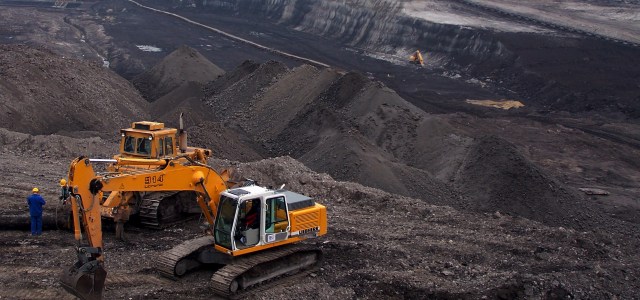The EU’s 2030 climate package contains free emissions trading allowances for Central and Eastern Europe’s carbon-intensive industries. Thereby, Brussels not only conceded to the environmental damage and long overdue changes to the market, but also to the possibility of corruption. Jan Ondrich explains.

This Polish lignite mine is brought to you by the EU’s 2030 climate package. (Photo by Anna Uciechowska, CC BY-SA 3.0)
The European Council agreed on a new climate package on 23 October 2014. The new deal obliges the EU to cut carbon emissions by 40% compared to 1990 levels; increase the renewable share of power production to 27%; and to increase energy efficiency by 27% until 2030 (although members state are not bound by this target).
Overall, the package is rather modest. The carbon reduction goal will have little impact on the ailing European carbon market (EU ETS) – the accumulated surplus of 2 bn allowances will not be eradicated and carbon price will remain largely irrelevant for energy projects in the next few years. The only hope for reviving the market comes from a speedy implementation of the stability reserve mechanism proposed by the Commission.
To make matters worse, the Council gave in to the Central and Eastern European countries (CEE – these countries have no serious environmental ambitions), making them eligible for free credits. Until 2030, member states with a GDP per capita below 60% of the EU average may give free allowances to the energy sector. No more than 40% of the total allowances to the member states may be handed out for free.
Free allocation of carbon credits to CEE countries facilitates corruption. In the worst case, the value of free allowances ends up being embezzled from overpriced and opaque contracts for power plant retrofits issued by local stated-owned incumbents. In the best case, they reinforce the market dominance of local incumbents, whose political clout ensures that they receive more allocations than their production would justify.
In all cases, free allocation strengthens the resilience of coal-based generation in CEE. Proceeds from the sale of these free carbon credits are often used to subsidise coal-based generation at the expense of cleaner technologies such as gas, renewables or energy efficiency. The proceeds are used to subsidise retrofits of coal-fired plants, which would have happened anyway, for example to comply with stricter emissions limits or to increase their flexibility. Free allowances are used as well to keep the cost of coal-based district heating far below the cost of gas-based heating, weakening the economic case for energy efficiency.
Free carbon credits to CEE countries are bad policy, exacerbating rather than alleviating the problems of local energy markets. In the same way that free allocations of the past have failed to reduce generation inefficiency, dominance of local incumbents, coal-based generation and consumption inefficiency, so too this latest decision will merely delay long overdue reforms.
Given the resources the EU devotes to fighting corruption, it is a sickening paradox that much of the value of free carbon allowances will now disappear into the pockets of local elites and petrify the old coal- and nuclear-based system.
Jan Ondrich is a partner in market analysis and advisory firm Candole Partners.
Why not eliminate carbon credits altogether?